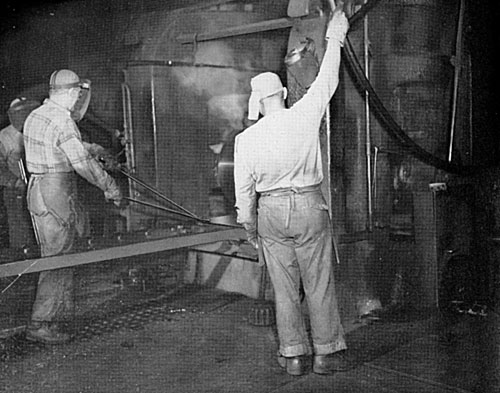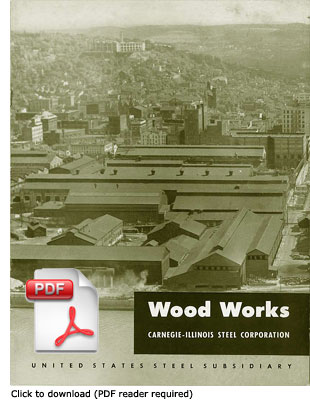Wood Works, 1949
(The following information about Wood Works was distributed by U.S. Steel Corp. during the late 1940s or early 1950s.)

Above: The entrance side of Wood Works' two-high hand mill. The rolling mill gives to the steel slab or sheet much of its "temper," wearing quality, and surface appearance. In the hot mills of Wood Works, perfect teamwork of expert rolling crews is reflected in the rolling operation, where the sheet, at initial white heat, is passed back and forth through the rolls for dimension and grain structure. Each pass through the hot mill reduces the thickness of the sheet approximately ten per cent, with three to five passes obtained in one heat. Often the sheet will be placed back in the furnace for additional reheating during the rolling process. Depending upon the gauge requirements, some sheets are rolled singly, or in packs of two, three and four.
 |
In many an American city or town, two houses, each representing a different age, may stand side by side . . .
One house will be very old—yet its trim lawns, white sills, and shining windows still show pride of good ownership. This house may be roofed with protected sheet steel, and although that roof has withstood rain, snow and heat for a great many years, it is still rust-free and weathertight, and has cost little for maintenance.
Next to it stands the "new house" in the block. Stainless steel is everywhere in this home—in the pots and pans that hang neatly within the cupboards; in basic household and basement appliances; in the casement windows that never warp, stick or rattle; in the gutters and downspouts that give brightness and freshness to the home.
Many years separate these houses, even though they are only yards apart. But the metal used in both had a common origin—the planished or protected sheet steel roofing in the older home; the bright U*S*S Stainless in the newer. The chances are good that both may have been made in the same plant—Wood Works—which is still operating at its original site, chosen in 1851, near the junction of the Monongahela and Youghiogheny Rivers at McKeesport, Pennsylvania.
It is with pleasure that the management and employees of Wood Works present you with this booklet, which tells of Wood Works' past and present contributions to the American steelmaking scene.
. . .
The year was 1851, and the elderly Henry Clay was delivering some of his greatest speeches on the floor of the United States Senate, when W. DeWeese Wood began to build a small, one-story plant on the south bank of the Monongahela River at McKeesport, Pa. One of the first sheet mills in the United States, Wood Works was also one of the first in America to develop and perfect the manufacture of sheet steel, which until that time had been almost exclusively a product of certain European mills. But in a few years, Wood Works was making its initial shipments of sheet steel into the American market, and thirty years after its founding, the plant was not only supplying the United States with large quantities of the product, but making shipments to Europe as well.
The product carried a name which developed into one of the "brand" names of the nineteenth century—"Wood's Patent Planished Sheet Iron." Users found that this metal had a long lasting finish that only extraordinary wear and abuse would remove. The highly ornamented locomotive jackets of the period were made almost exclusively of Wood Works sheet iron. The bodies of highest class stoves for homes and offices were very often made of this product, and it was also used extensively as a roofing material for homes throughout the United States.
Wood Works sheet iron was made entirely of knobbled bloom iron, and was subject to patent processes at various stages during its manufacture. At the start of this process, pig iron was placed in a coke refining fire, and when the iron reached its molten stage, it was run out and taken to the knobbling fires, where charcoal was used as the fuel. As the iron cooled, it was hammered into blooms, and then rolled down into bars. In the final reduction, the bars were rolled flat into sheets, washed and charcoaled, and baked for twelve hours before being packed according to gauge. The completed packs—ranging in size from forty to eighty sheets—were heated and hammered three separate times, given a final heat, and then trimmed, assorted, stenciled and packed. This product, along with another type of smooth black sheet that would not buckle under strain, was rolled and sold in large quantities under the trademark of the works.
In 1897. Wood Works joined the American Sheet Association, and four years later became a member of the United States Steel Corporation as a plant within the American Sheet and Tin Plate Company. In 1936, with the merger of the American Sheet and Tin Plate units into Carnegie-Illinois Steel Corporation, Wood Works became one of the fourteen plants of Carnegie-Illinois, the largest subsidiary of the United States Steel family.
The first loud honk of the automobile horn found its echo in Wood Works, where requests arrived from the new industry for the development of sheet steel for deep drawing to form fenders and other body parts. In subsequent experiments, Wood Works participated in the development of a steel sheet to which enamel would firmly adhere. This product reached the market under the trade name of U*S*S Vitrenamel.
In 1928, Wood Works began the rolling of stainless sheets, and at the present time Wood Works rolls a considerable portion of the stainless steel produced by the Carnegie-Illinois Steel Corporation, although stainless steels are also rolled in various forms at other Carnegie-Illinois plants, such as Duquesne, Homestead, Gary Sheet and Tin Mill, Gary Steel Works and South Works.
U*S*S Stainless is rolled and finished in many grades, as it may be processed by different fabricators into such varied items as milk and dairy equipment, airplane parts, costume jewelry, turbine parts, equipment for the chemical and dyeing industries, cooking utensils, tableware, surgical instruments, and a host of other products where corrosion resistance, resistance to oxidation at elevated temperatures, and great strength and ductility are required.
Shortly after World War II, announcement was made of a new and important steel alloy developed at Wood Works. Now known as U*S*S Stainless "W" (with the "W" standing for the plant's name), this new form of stainless steel utilized chromium, nickel and titanium alloying elements to form a product with a remarkable hardness obtained throughout its cross section by an age-hardening heat treatment. In our air forces, it was used on slides for pilot enclosures on fighting planes, as well as in
high stress structural parts of aircraft. It is used commercially in such products as plug valves, valve seats, pump valves, cams, rollers, ferrules and thrust plates.
While research and development activities are carried on at Wood Works, production and customer problems are also continually under consideration and study.
———
This article is from tubecityonline.com/steel, the Steel Heritage section of Tube City Online, P.O. Box 94, McKeesport, PA 15134.
Disclaimer
"United States Steel" and the USS logo are trademarks of United States Steel Corp. and no claim is made to them by Tube City Online. This work does not reflect current practices of United States Steel Corp. and is not endorsed or supported by the corporation in any way, shape or form. This is an historic document about a significant feature in the development of McKeesport. It is reproduced as an aid to researchers, students and the general public.It is averred that this document has fallen into the public domain because of non-compliance with U.S. copyright law, including lack of proper notice and failure to comply with manufacturing requirements. (17 USC 104a) This work was produced before 1978 but was not deposited with the U.S. Copyright Office. Further, it was published before March 1, 1989, but does not bear a copyright notice.
It is further averred that reproduction of this document falls under the "fair use" provisions of 17 USC 107 for the following reasons: 1.) This work is being reproduced for non-profit, educational purposes; 2.) This work was a publicity handout intended for widespread, free distribution; 3.) This work was produced before 1978 and was not copyrighted, nor does it bear the publisher's copyright notice; and 4.) There is no perceived potential value or market for this work.